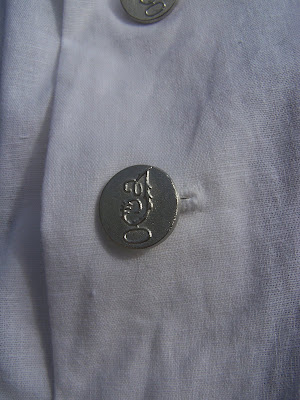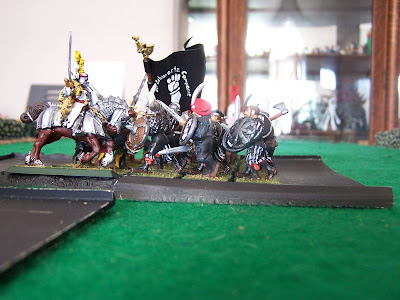Since my wife and I attempt to play Napoleonics using the
Shako rule set and only get in one or two games a year, we decided to find a way to play with smaller forces in order to get better with the rules. We decided that the War of 1812 in North America might be a good way to go for these "scrimages" as we called them. We tried out two (the games were that quick!) at the Hamlton Road Games Club on Saturday.
The first game to be attempted was a recreation of the Battle of Chippewa. Although small by European Napoleonic standards (about 2 Brigades on a side and small brigades at that.), the battle had great influence on both sides of the conflict. The Crown forces finally faced a force of US troops that could not be looked down upon. Winfield Scott's brigade was a regular force in every sense of the word: 4 battalions/"regiments" of US regular infantry, trained to a standard equal to just about any of the British line and maybe better than some. The US Army regained some self-respect and the respect of the Crown forces. Scott's brigade was pretty badly cut up in the battle, but was able to fight again at Lundy's Lane a short time later. (This makes me wonder how good a general Scott was, but I know for certain that he was a better general than me!) The battle between the light troops in the woods to the west of the main battlefield - mostly First Nations warriors on both sides and Pennsylvania/New York volunteers and detatched British light companies on either side- was so brutal that many of the First Nations withdrew from the war and declared neutrality.
In any event, here are some photos:
|
US Artillery and Infantry advance along the Niagara River.
(The battle took place not too far from the Falls.) |
|
Ripley's Brigade advances to aid Scott.
(The figures are ANCIENT Minifigs and Ral Partha 15's. I mean, reeeealy old.) |
|
The warriors of the Grand River First Nation battle Porter's light troops
-Cayugas and Pennsylvanians- in the forest. |
|
The forces involved were small. Leipzig, it was not! Hence two games. |
The US pushed back the Crown forces although taking some casualties from a battery of 24-pounders. The First Nations took serious casualties in the woods and some of the British regulars were smashed up badly. So we had time for a second game.
This one was North Point in the Chesapeake campaign around Baltimore. Here Maryland militia, still smarting from their defeat at Bladensburg, defended a rail fence as the British column came up to attempt to threaten Baltimore. (Althought Washington, DC was burned -to the eternal delight of many Canadians- Baltimore was the more strategic prize, being the center of privateer action on the Atlantic seaboard of the US.) In the actual battle, the Marylanders were to hold up the British advance so the fortification around Baltimore could be completed and although they lost the battle, they succeeded at delaying the British advance. The British commander, General Ross was killed in the battle by an American rifleman and that seemed to delay the column further. The British advance finally reached the completed fortifications on the land-ward side of Baltimore, but withdrew without taking on the 15,000 militia entrenched there. Fort McHenry guarded Baltimore harbour and that proved to be more than the fleet and invading troops were willing to handle. (cf. The Star-Spangled Banner, all verses)
 |
The British left - line infantry and Royal Marine Artillery Congreve rocket
batteries- advanced to fix the Maryland militia in place. The rockets were
fun - totally inaccurate and bizarre to fire. |
 |
The militia defends a rail fence... although it looks like a stone wall.
(I'm proud to say I painted the Maryland State flag carried by the
troops in the centre of the photo.) |
 |
Sailors and Royal Marines (masquerading as Highlanders) turned the US
left and drove in the line. The Maryland rifles sniped from the bog. |
 |
A British light infantry battalion counter-snipes from the farm. They should
be in red, but there's only so much time to paint. |
Since I didn't put enough woods on the board (compared to the real terrain), the British were easily able to turn the US left and send the militia packing. I suppose the miniature Baltimore was put to the torch.
So how does
Shako work for the North American war? Not real well, to be honest. It's written for mass battles in Europe and the War on 1812 just does not measure up in stature. We knew that from the beginning. But it does work! What this exercise DID do was permit us to practice the rules with minimal forces and less to carry to the club. More importantly, we had fun... which is why we do this in the first place! The most fun was trying to keep track of the Congreve rockets as they toured the Maryland countryside.































